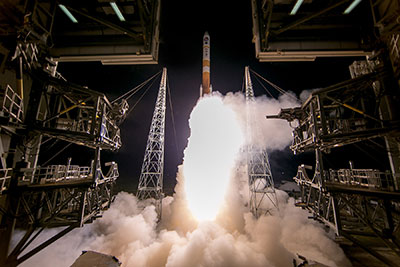 Space News space history and artifacts articles Messages space history discussion forums Sightings worldwide astronaut appearances Resources selected space history documents |
If you have previously registered, but forgotten your password, click here.
This mission was launched aboard a Delta IV Medium+ (5, 4) configuration Evolved Expendable Launch Vehicle (EELV) powered by one common booster core and four solid rocket motors built by Orbital ATK. The common booster core was powered by an RS-68A liquid hydrogen/liquid oxygen engine producing 705,250 pounds of thrust at sea level. A single RL10B-2 liquid hydrogen/liquid oxygen engine powered the second stage. The booster and upper stage engines are both built by Aerojet Rocketdyne. ULA constructed the Delta IV Medium+ (5,4) launch vehicle in Decatur, Alabama. This is ULA's 3rd launch in 2017 and the 118th successful launch since the company was formed in December 2006. "Thank you to the women and men of United Launch Alliance and all of our teammates who have worked tirelessly together to ensure today's mission success," said Maginnis. "The team's number one priority was safely and reliably delivering one of our nation's most critical satellites."  WGS-9, the third Block II Follow-on satellite, supports communications links in the X-band and Ka-band spectra. The WGS-9 satellite will be able filter and downlink up to 8.088 GHz of bandwidth. WGS satellites are an important element of a new high-capacity satellite communications system providing enhanced communications capability to our troops in the field. The EELV program was established by the U.S. Air Force to provide assured access to space for Department of Defense and other government payloads. The commercially developed EELV program supports the full range of government mission requirements, while delivering on schedule and providing significant cost savings over the heritage launch systems. | ||||||||
